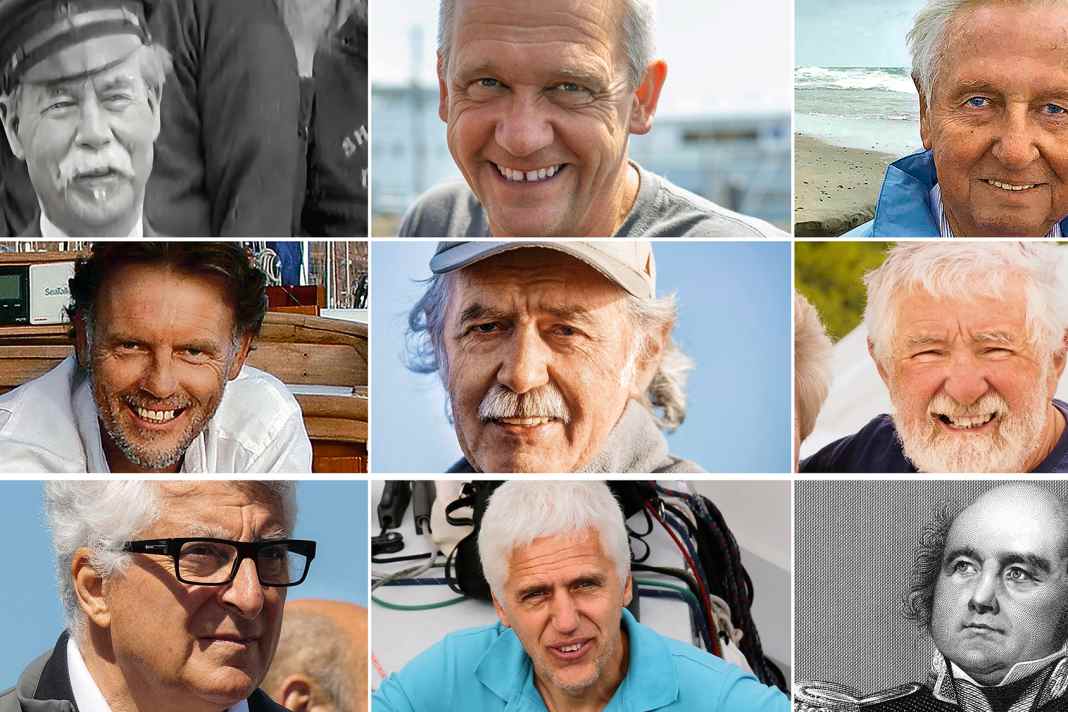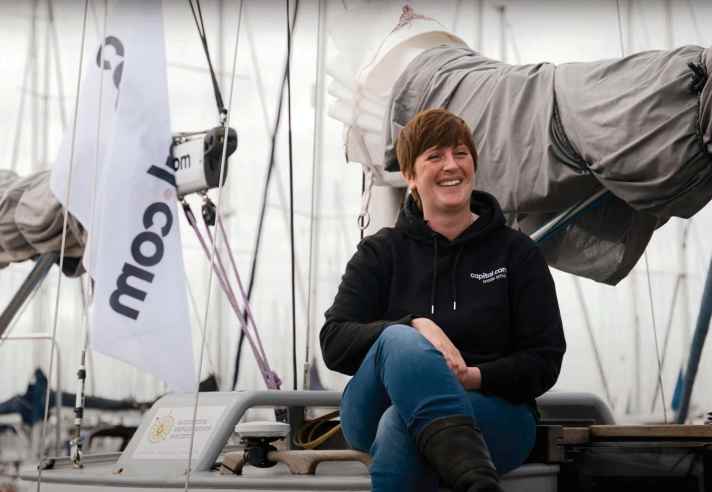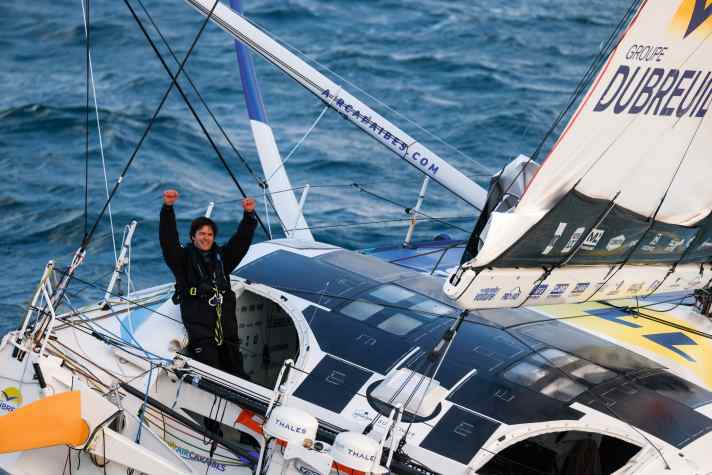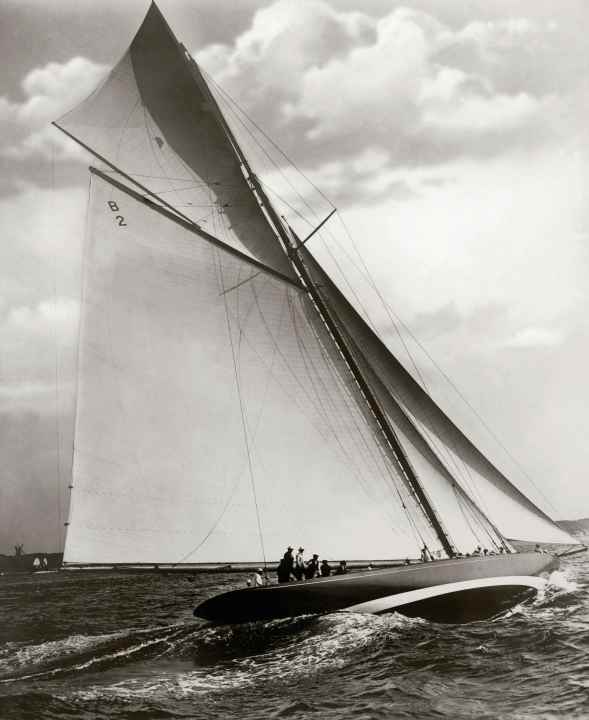





- Technology as a record driver
- Once unthinkable, now possible
- The German role model Wilfried Erdmann
- Gerd Engel: The pilot from the Harz Mountains
- Dogged by bad luck
- A scandalous circumnavigation of the globe
- Donald Crowhurst: A victim of public pressure
- Lipton: The best of all losers
- Patrizio Bertelli: The Lipton of modern times
- Norbert Sedlacek: The indefatigable
- Sustainable failures
- Where the hunt for records is just beginning
This news item at the end of May caused quite a stir: "British woman sets off on historic circumnavigation of the Arctic." What Ella Hibbert is undertaking here is a remarkable adventure. She wants to cross both the Northwest and Northeast Passages in just five months. It would be a sensation - and a new record at the same time. The 28-year-old would be the first person to circumnavigate the Arctic on one and the same journey.
Climate change and the associated decline in sea ice are making it possible. While adventurers from all over the world have been searching for a navigable passage for centuries, scientists currently assume that there will be no more Arctic ice in summer by 2050.

Hibbert will therefore not be the last record hunter to set off for the Arctic. The list of potential "firsts" is already long: be it with one, two or three hulls through the Arctic Ocean; as the first European, German or German-speaking sailor; with a crew or perhaps without?
Technology as a record driver
Meanwhile, records are being set not only in the far north. While climate change is making new pioneering achievements possible there, elsewhere it is technological progress. This was recently demonstrated at the Vendée Globe, where the sailors broke several records at once on their high-powered IMOCA yachts.
Charlie Dalin managed to literally pulverise the record time of the race. With a time of 64 days, 19 hours and 22 minutes, he was ten days faster than the previous record holder Armel Le Cléac'h.

A similar picture emerged for the distance sailed within 24 hours. This record was broken several times in just a few days - first by Yoann Richomme with his "Paprec Arkéa" and shortly afterwards by Sébastien Simon. He broke the 600 nautical mile mark with his "Groupe Dubreuil" and beat his own record shortly afterwards. The Frenchman is now ranked number one by the World Sailing Speed Record Council (WSSR), which records and recognises such records, with 615.33 nautical miles in 24 hours (for monohulls up to 60 feet).

But the record celebrations did not end there. Yoann Richomme also broke four other records, including the best split time (43 days) and the highest average speed (17.9 knots). Jean Le Cam pushed the age limit further up, while Violette Dorange, the youngest female sailor, pushed it further down.
The fascination of records
Time and again, sailors set out to push the boundaries of what is possible in sailing. The hunt for "faster, further, better" seems endless. And although many limits have already been reached, there is always a record in the headlines. But what makes records so fascinating? And what role do they play in sailing?
One person who has been observing the hunt for records in sailing from a professional perspective for over two decades is Jochen Rieker. The former editor-in-chief of YACHT knows: "Records help to strengthen your own discipline and to do things that common sense would oppose."
Once unthinkable, now possible
For a long time, the Northwest Passage was considered impossible. Hundreds of people died in the attempt - including the British polar explorer Sir John Franklin. When it later succeeded, the passage was unthinkable without spending the winter in the ice. Today, even a complete circumnavigation of the Arctic in just one summer seems possible.
And the time for the fastest non-stop circumnavigation of the world is also shrinking all the time. While Sir Robin Knox-Johnston took 312 days in 1969, Francis Joyon and his trimaran "IDEC" completed the circumnavigation in just 40 days in 2016/17.
"I think the fascination unfolds when something is considered impossible for a long time and is then achieved. This universal magnetism attracts the media and inspires people's imagination," says Rieker.
Striving to be better than others
Constanze Stolz-Klingenberg, association psychologist at the German Sailing Association (DSV), says: "We tend to measure our goals against concrete results. They are often based on the fact that we want to do better than others."
When people pursue their goals and prevail against others, this can trigger a feeling of happiness. Striving for this, says the sports psychologist, is deeply rooted in people. Especially when the goals contain a touch of dreaming, they unfold their full power.
Breaking records is only one side of the coin. On the other side are the countless attempts, all those who set out to achieve the extraordinary - and failed.
The German role model Wilfried Erdmann
Looking at Germany, there is hardly any other endeavour that illustrates this more clearly than the attempt to follow in Wilfried Erdmann's wake. The first German single-handed circumnavigator (1968) sailed around the world twice alone and non-stop along the three southernmost capes. Once with (1985) and once against (2001) the prevailing wind direction.
More about Wilfried Erdmann:
Since then, more than half a dozen German skippers have tried to do the same. One who has succeeded is Susanne Huber-Curphey. She was the second German to circumnavigate the globe single-handed and non-stop, making her the first German woman to achieve this feat. However, most German attempts failed in the Atlantic, even before reaching the "Roaring Forties". Some even failed on their doorstep in the North Sea.
On the trail of Erdmann - an overview:

Gerd Engel: The pilot from the Harz Mountains
Gerd Engel has come a long way and yet failed. In 1999, he began his non-stop circumnavigation with the 18-metre catamaran "Sposmoker II". Initially, the signs were good for the pilot from the Harz Mountains. He had previously travelled to the Antarctic and to Spitsbergen, which gave him a tailwind for his project.
But while attempting to sail around the world, he first breaks a shroud in Brazil. Later, the mast comes down from above. With an emergency rig, he saved himself by travelling 2,000 nautical miles to the island of Ascension, south of the equator. There he builds a new mast and ends his attempt by sailing home to Germany.
Dogged by bad luck
In the summer of 2001, Jörg Lehmann from Berlin sets off on his "Kreuz As Alu". After 51 days at sea and 3,200 nautical miles off Cape Town, he experiences problems with the cooker that he cannot fix. He breaks off and returns to the Cape Verde Islands. But fate was not kind to Lehmann. A line gets caught in the propeller off São Vicente. His boat ran aground and sprung a leak. After salvaging the boat, Lehmann sells it and travels back to Germany.
Wolfgang von Pappritz has a similar goal, but nowhere near as far. The man from Winsen cast off twice, but twice he failed in the North Sea. In 2005, he made it as far as the Dutch coast with his steel ketch "Tharos". There he collided with an object in the water. The drive shaft is damaged; his boat leaks and he eventually turns back. A second attempt followed a year later, but this also failed because the drive shaft was again taking on water.
In 2015, Henrik Masekowitz from Hamburg wants to find out. He already has offshore experience and is considered a beacon of hope. He set off with his Class 40 "Croix du Sud" and wanted to break the record time for the class (137 days). But shortly before reaching Cape Town, he breaks his foot; it's the end.
A scandalous circumnavigation of the globe
In summer 2009, Bernt Lüchtenborg set off from Cuxhaven with the ambitious goal of sailing around the world not once, but twice - once with and once against the wind. Similar to what Wilfried Erdmann had once achieved. But instead of achieving fame, his voyage became a media-orchestrated scandal.
Because Lüchtenborg is cheating. He misleads his sponsors and fans about the actual course of the voyage. In Norderney, he secretly takes a fellow sailor on board and conceals further harbour calls. He later suffers rudder damage in the Pacific and cancels the circumnavigation.
As it later turned out, the first signs of his fraud became known just a few weeks after the launch, when he anchored off the Cape Verde Islands. However, the full extent only came to light months later. Back in Germany, he was sued for fraud by his main sponsor.
But Lüchtenborg is not the only one to come to the media's attention through deception. Even during the 1968/69 Golden Globe Race, which is considered the first non-stop solo round-the-world race, the Briton Donald Crowhurst caused a sensation.
Donald Crowhurst: A victim of public pressure
In the run-up to the race, he is seen as a likeable outsider. He has the least experience and his trimaran, which he is building especially for the race, is presented as a technical marvel. Much of the equipment on board is considered "state of the art", but the costs explode during construction - and the boat is not finished on time. Crowhurst is faced with a dilemma: if he cancels the race, he has to reimburse his sponsors for the construction costs. But that would ruin him.
Under increasing pressure, he sets off - and only fakes his circumnavigation. He falsifies logbooks and radios false positions. Instead of rounding the capes, he cruises around the Atlantic. His notes later reveal that loneliness and the fear of being discovered drive him mad. He eventually commits suicide in the middle of the Atlantic.
Lipton: The best of all losers
Painful disappointment is an inevitable part of failure. But the way it is dealt with varies. A look at the history of the America's Cup reveals numerous examples of this. British tea merchant Sir Thomas Lipton, for example, went down in history for his perseverance and tenacity, even after failing several times.
Between 1899 and 1930, he attempted to win the America's Cup five times. With his yachts "Shamrock I" to "Shamrock V", Lipton was defeated by the American defenders every time, even when he competed with great effort, ambition and changing designers.

"Failure gives depth and meaning"
His defeats were so remarkable that he went down in history as "the best of all losers". Although he was denied a sporting triumph in the America's Cup, Lipton was a highly respected and popular figure in the sailing world. And he did not leave the race without a win: His perseverance made the "Lipton" tea brand famous throughout the USA.
In fact, multiple failures even lend depth and meaning to a record - provided they are based on serious attempts," says Jochen Rieker. And sports psychologist Stolz-Klingenberg also sees failure as more than just a defeat. "It often provides valuable insights into where deficits existed or where others who were pursuing the same goal made smarter decisions. That can be enormously valuable."
Patrizio Bertelli: The Lipton of modern times
Italian entrepreneur Patrizio Bertelli might have thought the same. As team boss of "Luna Rossa Prada Pirelli", his personal record in the America's Cup is similar to that of Thomas Lipton - it even surpasses it. In 2024, he had to accept his sixth defeat when he was eliminated from the Louis Vuitton Cup. This did not dampen his spirits: one day after his elimination, he officially announced that his racing team would also be taking part in future Cups.

Norbert Sedlacek: The indefatigable
Austrian Norbert Sedlacek also epitomises this tirelessness. In recent years, he has repeatedly had to battle with setbacks. In 2013, he wanted to prove the suitability of a new volcanic fibre sail and sail across the Atlantic with the 4.90-metre-long "Fipofix" built from it. But he had to give up after just a few weeks.
He later expands his ambitions further. This time he plans to circumnavigate the globe - non-stop, single-handed and also round both poles. To do this, he is building a 60-foot Imoca derivative called the "Ant Arctic Lab". It consists of basalt fibres and bio-based epoxy resin. But all five attempts failed. Technical problems or material damage often occur. Sometimes after just a few days at sea.
Sustainable failures
His career is not only characterised by setbacks, but also by sporting achievements. In 2001, he was the first Austrian to circumnavigate Antarctica and in 2009 he successfully completed the Vendée Globe at his second attempt. But in the end, the setbacks stuck. He himself takes a sporting view. Before his last attempt, he said:
"Failures are more important and more sustainable than quick success with an immature project."
Sports psychologist Stolz-Klingenberg also believes it makes sense to plan for failure. For athletes, it is important to find satisfaction not only in achieving goals, but also on the way there. "It's about the feeling of having done something right that you can be proud of."
Where the hunt for records is just beginning
It is true that you learn a lot from failure and can learn valuable lessons, says Jochen Rieker. However, he believes there are limits to this: "If failures happen too early and too often, it's also a sign that you've tried to do too much." The public may therefore be less willing to pay attention to such an attempt.
With the circumnavigation of the Arctic being undertaken by Briton Ella Hibbert, this should not be too much of an issue. If she fails to complete the circumnavigation, it is only a matter of time before the next contender makes the attempt. After all, while the limits are largely exhausted elsewhere, the race for records in the Arctic has only just begun.

